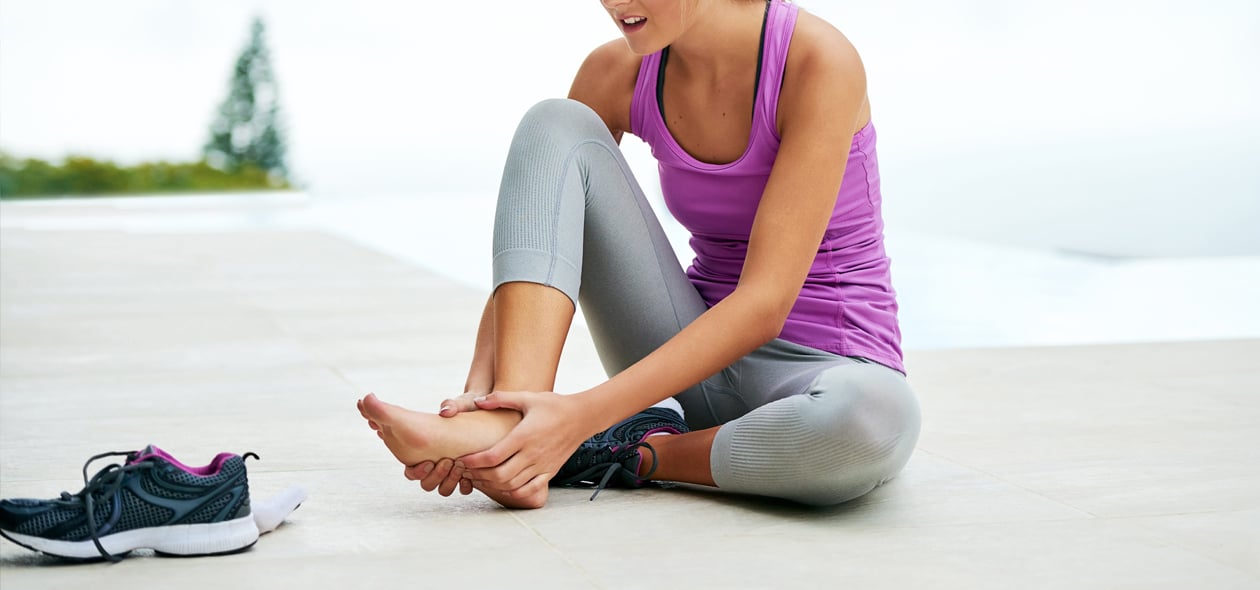Why do I have heel pain? – Do I have Plantar Fasciitis?

According to research 1 in 10 of us will suffer with heel pain at some time in our life. By far the most common cause of heel pain is Plantar Fasciitis, this blog will hopefully shine some light on the pain in your heel, help you understand what it is and give you some pointers on how to rid of the problem.
So what are the symptoms of Plantar Fasciitis (heel pain)?
I’d imagine if I were to ask you what the problem is other that the obvious “I have heel pain” most of you with Plantar Fasciitis would describe pain on the inside front edge on the bottom of your heel. Most will also describe how painful it is when they first get out of bed in the morning and after periods of rest or inactivity. By the time people end up in my clinic they have usually been suffering with problem for a few months and have had enough.
So what is Plantar Fasciitis (heel pain)?
The Plantar Fascia is fibrous band of connective tissue that connects the heel to the toes, the “itis” part of the name is originally Latin and we know the meaning in medical terms as inflammation. Therefore Plantar Fasciitis is the inflammation of the Plantar Fascia. The Plantar Fascia has the role of maintaining the foot’s shape and it also assists with the propulsive phase of gait.
What causes Plantar Fasciitis?
There are a number of factors that can contribute to the cause of your heel pain. When we look at foot type we find that a lot of people who suffer with Plantar Fasciitis have a tendency to roll in at the foot/ankle too much – this is called excessive pronation. Excessive pronation in the foot/ankle will lead to increased lowering of the medial arch and increase deviation of pressure to the inside of the foot therefore increasing the loading forces on the Planar Fascia. Foot type alone can’t be responsible for the injury so we must consider other factors:
Footwear:
I believe strongly that poor footwear is one of the biggest contributors to Plantar Fasciitis, we have certainly seen a connection to shoes with less support increasing stress on the supportive Plantar Fascia. One of the best ways to understand this is with ladies and the seasonal changes that occur with their footwear. In the winter we are seeing ankle boots with a small heel and decent amount of support, however come April /May time when the weather changes we will see an immediate change to ballet pump type shoes or sandals. Effectively what we have here is a very quick change from supportive shoes to non-supportive shoes very quickly. So do your feet a favour and make the transition over a period of time or avoid overly unsupportive shoes at all.
Occupation:
Simple physics tell us that the more time you spend on your feet the more stress you put on them, so people who are standing/walking for a living can be more prone to painful feet and heels. Your shoes become very important for foot health if you fall into this category. Looking for supportive shoes with approximately 1cm heel to gradient is a good place to start.
Weight:
Again physics tells us that the heavier we are the more pressure we are likely to put on our feet. Increasing support under and around the foot can certainly help in reducing excessive strain on your feet. Rugby players should be avoiding football boots designed for people who are much lighter and stick to better constructed boots designed for bigger, heavier builds.
Sports and Activity:
We would assume that the more you run the more likely you are to suffer with Plantar Fasciitis, well from my experience it seems to occur in people who change something in their training schedule to quickly – whether you suddenly increase your mileage or are returning from injury make sure you graduate your return over a period of time. The human body is great at adapting to change as long as you give it enough time to adapt.
So, I have heel pain, what do I do now?
There are some simple things that you can start to incorporate into your daily routine:
1. Before you get out of bed throw a scarf or tie around your forefoot and pull the foot towards your body – this stretches your calf and fascia and can make getting out of bed a bit less painful.
2. Use a Pediroller on numerous occasions throughout the day – putting it in the freezer will further reduce discomfort and encourage healing.
3. Make sure you are avoiding unsupportive footwear – flip flops and ballet pumps are going to make your foot worse.
4. Calf stretches on a daily basis at least 3 x 10 minutes per day.
How can we help?
A Podiatrist will assess the foot and ankle and address any biomechanical issues that may be increasing day to day strain on the plantar fascia.
Here at ACE we specialise in gait analysis and orthotic therapy which will allow us to address to any mechanical stress on the fascia. We also offer shock wave therapy which compliments our other services by stimulating a healing process when the condition is chronic.
These treatments work well separately and combined together. For more information on gait analysis click here and for shock wave click here.